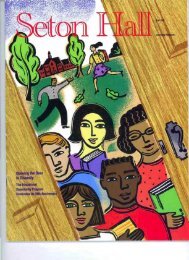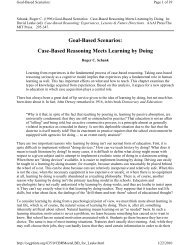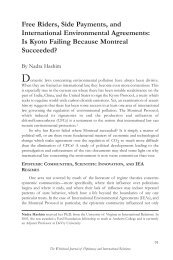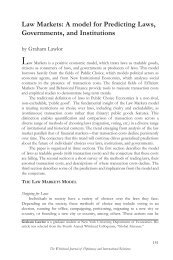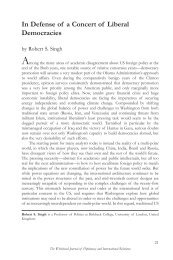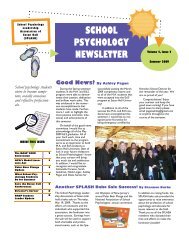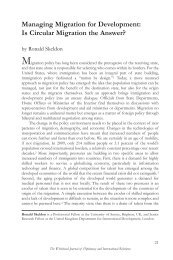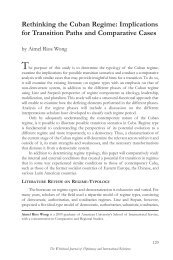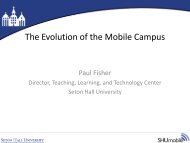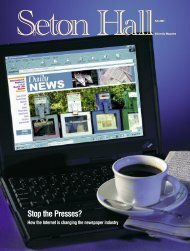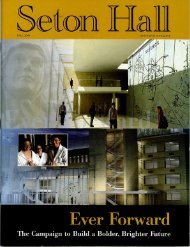Seton Hall Magazine, Winter 2000 - Seton Hall University
Seton Hall Magazine, Winter 2000 - Seton Hall University
Seton Hall Magazine, Winter 2000 - Seton Hall University
Create successful ePaper yourself
Turn your PDF publications into a flip-book with our unique Google optimized e-Paper software.
BY MONSIGNOR ROBERT SHEERAN ’67<br />
Although I’m a bit millennium weary at the<br />
moment — convinced, despite predictions, that<br />
the sky will not fall on New Year’s Day — I was<br />
intrigued recently by a book that addresses some<br />
of the challenges we all face at <strong>Seton</strong> <strong>Hall</strong> in the<br />
year <strong>2000</strong>, and beyond. The Lexus and the Olive Tree by New York<br />
Times Foreign Affairs columnist Thomas L. Friedman looks<br />
at the tension between tradition and change in an increasingly<br />
global economy. How does a sense of community<br />
survive in a world of crumbling borders, e-commerce, Coca-<br />
Cola from Boise to Beijing? It’s a question<br />
easier to ask than to answer. For Friedman,<br />
the “Lexus” symbolizes the human drive for<br />
enrichment and the “Olive Tree” a desire for<br />
identity, stability and belonging. Those conflicting<br />
hopes have always been at the heart<br />
of the human story, but today they have<br />
acquired a new urgency. Equipped with<br />
modems and laptop computers, we are at<br />
home everywhere and yet nowhere.<br />
Connected to others, we are too often disconnected<br />
from ourselves. That, more than Y2K<br />
glitches, is what ought to make us anxious<br />
about our brave new world.<br />
It’s no wonder that, as president, I was<br />
drawn to the book. Friedman’s analysis works for <strong>Seton</strong> <strong>Hall</strong> as<br />
well as for the larger world. Every day, as we seek to improve<br />
the <strong>University</strong>, we find ourselves embracing an unknowable<br />
future guided only by an unchangeable past. Soon the<br />
<strong>University</strong> will be 150 years old. What lessons can we learn<br />
from our history that will shape our destiny? My vision is that<br />
<strong>Seton</strong> <strong>Hall</strong> will become one of the world’s great Catholic universities.<br />
If we are to succeed in this collective endeavor we<br />
must recognize that change for its own sake is foolish but that,<br />
equally, uncritical attachment to the past is not the sign of<br />
spiritual health. The trick is to get the balance right.<br />
One rather obvious question is: What signs and symbols are<br />
worth keeping? Students in every era want to know their<br />
school traditions. Interestingly, it is our more recent alumni<br />
who have been responsible for establishing two new symbols<br />
— the Alumni Clock by the Walsh Library and the Pirate statue<br />
in front of the Recreation Center. And each new class is offered<br />
the traditional caution that to step on the <strong>University</strong> seal at the<br />
center of the Green is to impede graduation. Generally those<br />
things that each of us likes about the <strong>University</strong> we hold dear<br />
and refer to as traditions.<br />
44 SETON HALL UNIVERSITY MAGAZINE<br />
r<br />
Endpaper<br />
Tradition and Change: The Balancing Act<br />
On the other hand, those things we dislike, despite their<br />
age and venerability, we regard as innovations that have outstayed<br />
their welcome. Earlier this year, when the <strong>University</strong><br />
unveiled its new logos, I received a message from an alum<br />
who was annoyed that we had discarded our old Pirate. That<br />
logo, he said emphatically, was part of <strong>Seton</strong> <strong>Hall</strong>’s “tradition.”<br />
I didn’t have the heart to tell him that the pirate in question<br />
had only represented our athletic teams since 1988!<br />
These attachments — to signs and symbols, traditions and<br />
rituals — are forms of affection. They are ways of saying that<br />
we feel at home. Yet, we all know that no<br />
home ever stays the same. How should <strong>Seton</strong><br />
<strong>Hall</strong> define itself as an institution in the<br />
coming years? As we strive to enhance our<br />
academic reputation, will we measure ourselves<br />
only by national college rankings, SAT<br />
scores, endowment per student, annual percentage<br />
of alumni giving? These things are<br />
important, of course, but somehow they miss<br />
the distinctiveness of education at a great<br />
Catholic university. Looking at <strong>Seton</strong> <strong>Hall</strong>,<br />
I am conscious that others see in us much to<br />
envy. But I hope they see that our greatness<br />
lies not in bricks and mortar, a fine faculty, a<br />
dedicated staff, a wonderful student body.<br />
I give thanks for all these gifts. But scholarship, properly<br />
understood, is a matter of the soul. We achieve very little if<br />
we produce only graduates and not good people.<br />
Yet is this anything new? Hardly. We’ve been there already,<br />
many times before. Our future will look surprisingly like our<br />
past. There will be mistakes and false starts, as with any<br />
human enterprise, but there will be splendid achievements<br />
too. I am convinced that the dramatic changes in technology at<br />
the <strong>University</strong> — our effort to climb into Thomas Friedman’s<br />
Lexus — will usher in many of those achievements. We should<br />
be proud of what we have done so far and excited by the<br />
prospect of doing more.<br />
All the same, there is a deeper sense in which the past offers<br />
a signpost for what lies ahead. The great English author<br />
G.K. Chesterton wrote “tradition is the democracy of the<br />
dead.” Older generations do not cease to offer us lessons<br />
simply because they are no longer around. Think of our own<br />
tradition. When Bishop Bayley founded <strong>Seton</strong> <strong>Hall</strong> in 1856, his<br />
hope was that it should be a “home for the mind, the heart and<br />
the spirit.” That was a good principle then and is a good principle<br />
today. Something tells me it will also work tomorrow.<br />
Monsignor Robert Sheeran ’67 is president of <strong>Seton</strong> <strong>Hall</strong> <strong>University</strong>.



